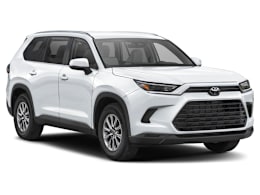The Grand Highlander fills a niche in the Toyota SUV line, providing more room than the traditional Highlander, without the truckiness and clumsiness of the full-sized Sequoia. It’s better positioned to stave off the growing competition in the midsized three-row SUV class, which includes the Honda Pilot, Hyundai Palisade, Kia Telluride, and the all-new Mazda CX-90—all of which are roomier and more feature-laden than the regular Highlander.
The Grand Highlander’s extra 6 inches of length aids interior space, makes for easier rear-passenger access, and provides more cargo room compared to the regular model. It shares the turbocharged four-cylinder and hybrid powertrains with its namesake, while borrowing a performance-oriented turbocharged hybrid from the Lexus RX500h and Toyota Crown Platinum.
We found the Grand Highlander to be comfortable and roomy, with a legitimately adult-friendly third-row seat and bountiful cargo space. Plus, the standard 2.4-liter turbocharged four-cylinder delivered the same fuel economy as the regular Highlander. But overall it’s more grande than it is “grand.” While the functionality is there to satisfy Toyota loyalists who might otherwise be drawn to a vehicle like the Pilot, the Grand Highlander’s turbocharged four-cylinder engine lacks refinement, and the vehicle is short on rewarding features and touches that buyers should rightfully expect at its price.
Press hard on the gas pedal and the standard 265-horsepower, 2.4-liter turbocharged four-cylinder engine delivers ample thrust and plenty of midrange torque. But the engine sounds gritty and unappealing, and the eight-speed automatic transmission delivers some slightly rough shifts, especially in lower gears. It also requires throttle-modulation practice to be smooth taking off from a stop, as the power comes on abruptly. By the numbers, the Grand Highlander is nearly a second slower from 0 to 60 mph than key competitors, but the 22 mpg overall it managed in our testing is competitive, and matches the smaller and lighter Highlander.
Unlike many three-row midsized SUVs, the Grand Highlander isn’t available with a six-cylinder engine. There is a thrifty 2.5-liter four-cylinder hybrid that we’ll test soon, along with a turbocharged hybrid powertrain on top trims that we found to be quite impressive when we rented a version from Toyota.
The Grand Highlander’s ride is cushier than most competitors, particularly with the smaller 18-inch tires that come on the XLE we tested. (Higher trims come with larger 20-inch wheels and tires.) The suspension does a good job absorbing all but the harshest bumps, although it’s not as comfy as the uber-plush Subaru Ascent. Point the Grand Highlander toward a curve and it handles reasonably well during regular driving, aided by a natural feel from the steering. But when you pick up the pace it gets ungainly, with an early onset of body roll and less willingness to be driven with urgency than the smaller Highlander. It proved secure when pushed to its limits around our track, but posted a 3-mph slower speed through our collision-avoidance test than the regular Highlander. If you’re in the market for a midsized three-row SUV that handles with more aplomb, look to the Mazda CX-90.
The front seats proved comfortable for many body types, with plenty of adjustments and decent support. There’s lots of headroom, an elevated driving position, and well-positioned armrests. The Grand Highlander can be configured to hold seven or eight passengers by either opting for a second-row bench seat or two individual captain’s chairs. The second-row seat has excellent underleg support, great foot space under the front seats, and plenty of knee room. But the flat, unsupportive seatback can become tiresome on road trips.
Hop into the third row and you’ll find one of the roomier ones in the midsized segment, capable of accommodating adults for short trips. Toyota’s lever-operated mechanism moves the second-row seat forward to create a path to the third row with a single pull (and a slight shove), but it’s not as slick as the simpler, push-button setups of some competitors. Maximum cargo capacity (with both the second- and third-rows folded down) benefits from about 7 extra cubic feet compared to the regular Highlander.
Interior fit and finish isn’t all that impressive, and pales in comparison to midsized SUVs such as the Hyundai Palisade, Kia Telluride, and Subaru Ascent. The XLE we tested lacks much in the way of special touches, such as a felt-lined glove box or an abundance of well-padded surfaces. For nicer Highlander furnishings, such as real leather (rather than the “SofTex'' imitation leather in our XLE), buyers have to opt for the top Limited and Platinum trims.
Most controls inside the Grand Highlander are easy enough to use, including the conventional gear selector, and we appreciate the physical knobs and buttons that handle many common tasks. The infotainment system’s touchscreen is large and modern looking, but because there isn’t a “home” screen it can be tedious to jump between menus, such as the radio and navigation. We also found it confusing to wade through all the menus within the driver’s instrument screen. At least there is an audio volume knob, albeit a very small one, on the driver’s side of the infotainment screen.
The Grand Highlander comes standard with the “Toyota Safety Sense 3.0” suite of active safety and driver assistance features, which includes automatic emergency braking with pedestrian, cyclist, and motorcycle detection, along with lane centering assistance, lane departure warning, lane keeping assistance, adaptive cruise control, and automatic high beams. TSS 3.0 also includes Proactive Driving Assist. In some situations, this feature can provide gentle braking and/or steering assistance based on radar and camera information to help with turns, following behind other vehicles, and responding to a pedestrian or bicyclist. Automatic emergency braking that operates at highway speeds, blind spot warning, and rear cross traffic warning also come standard on the Grand Highlander.


























